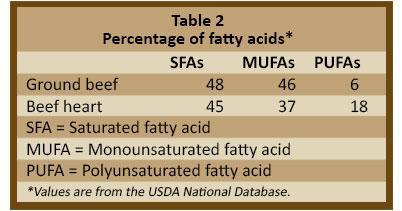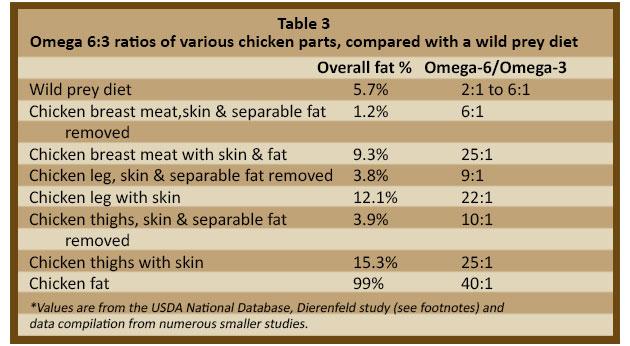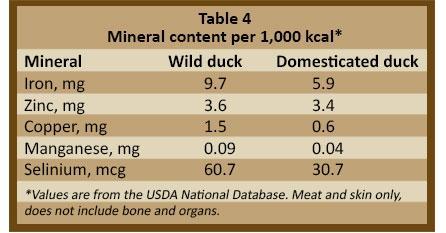This content is archived from the Feline Nutrition Foundation
Care to Compare? Wild vs. Domesticated Prey
- Updated: Sunday, June 02, 2019 02:34 PM
- Published: Saturday, June 21, 2014 06:20 PM
- Written by Steve Brown
 As obligate carnivores, cats evolved eating wild prey animals. Now we feed them mostly domesticated and farmed meats. The differences between domesticated food animals and prey animals are especially important for those of us trying to mimic the diet that cats evolved eating. Even if one can feed the entire domesticated animal, including the nutrient-dense blood, plasma, tongue, pituitary, adrenals, prostate, brains, eyes and testes, the nutrient content would not match that of wild prey. The differences would be large: domesticated animals have less protein, more fat, often with an unhealthy balance, fewer minerals and fewer antioxidants.
As obligate carnivores, cats evolved eating wild prey animals. Now we feed them mostly domesticated and farmed meats. The differences between domesticated food animals and prey animals are especially important for those of us trying to mimic the diet that cats evolved eating. Even if one can feed the entire domesticated animal, including the nutrient-dense blood, plasma, tongue, pituitary, adrenals, prostate, brains, eyes and testes, the nutrient content would not match that of wild prey. The differences would be large: domesticated animals have less protein, more fat, often with an unhealthy balance, fewer minerals and fewer antioxidants.
Pastured and free-range animals, while better than feed-lot fed animals, still have more storage fat than wild animals, as they are still fattened up. Due partially to the higher fat content, the mineral content of free-range meats, measured on caloric bases, are still lower than that of wild prey. Wild prey animals have more calories from protein than fat. Domesticated animals have more calories from fat than protein.
 There are few fat prey animals in the wild. On the other hand, modern food animals are intentionally fattened up, often with low-cost grains. The more the animal weighs, the more money it's worth. Table 1 shows a good example: a fat and protein comparison of wild duck (USDA defined as duck, wild, meat & skin, raw, with refuse 40%: 38% bone, 2% handling loss) and domesticated duck (duck, domesticated, meat and skin, raw, with refuse: 28%, bone). This is the only direct comparison of the same parts of wild and domesticated animals I could find using USDA data.
There are few fat prey animals in the wild. On the other hand, modern food animals are intentionally fattened up, often with low-cost grains. The more the animal weighs, the more money it's worth. Table 1 shows a good example: a fat and protein comparison of wild duck (USDA defined as duck, wild, meat & skin, raw, with refuse 40%: 38% bone, 2% handling loss) and domesticated duck (duck, domesticated, meat and skin, raw, with refuse: 28%, bone). This is the only direct comparison of the same parts of wild and domesticated animals I could find using USDA data.
Domesticated duck has more than twice the fat and almost twice the number of calories per pound as wild duck. From a macronutrient point-of-view, they are two different animals. Please note that the amount and types of fat in prey animals varies considerably by time of year, the size, sex, health, and age of the prey, what the prey ate, the presence of predators and other factors.
All of the other data I've seen, and I look at lots of it, confirm that wild animals are much leaner than domesticated animals. The USDA data include a comparison of wild and domesticated rabbits. While I'm not sure the USDA is testing the same parts of the rabbits, the difference in total fat content is certainly significant. Wild rabbit contains 21.8% protein and 2.3% fat. Domesticated rabbit contains 20.1% protein and 5.6% fat, more than twice the fat content of the I-need-to-run-to-save-my-life wild rabbit.¹ Mice and other small prey were a major part of the cat's evolutionary diet. Mice are well studied; zoo biologists have examined the protein and fat content of almost 1,000 mice. The average of the mice studied is 58% protein, 23% fat on a dry matter basis, more calories from protein than fat.²
Wild prey animals have a different balance of saturated, monounsaturated and polyunsaturated fats than domesticated animals of the same species. The differences are due to the sometimes dramatically different diets, and the sedentary nature of food animals.
Beef and Ruminants: Too Much Saturated Fats, Not Enough Polyunsaturated
 Beef is very high in saturated fats, and low in polyunsaturated fats. As table 2 shows, even the organ fats in domesticated ruminants are primarily saturated fats; in wild animals organs are usually higher in polyunsaturated fats than saturated fats.³ While many experts in fatty acids disagree on the value of saturated fats, whether they are healthy or not, my point is that – when feeding beef, lamb and venison foods – the saturated fats are out of balance.
Beef is very high in saturated fats, and low in polyunsaturated fats. As table 2 shows, even the organ fats in domesticated ruminants are primarily saturated fats; in wild animals organs are usually higher in polyunsaturated fats than saturated fats.³ While many experts in fatty acids disagree on the value of saturated fats, whether they are healthy or not, my point is that – when feeding beef, lamb and venison foods – the saturated fats are out of balance.
Poultry: Too Many Omega-6 Fatty Acids
As we saw with ducks, most commercially-produced poultry, especially chickens, are much higher in fat than wild prey. While the overall balance of saturated and polyunsaturated fats in poultry is more in line with a wild prey diet, there are far too many omega-6 fatty acids and not enough omega-3 fatty acids. Almost all fatty acid experts agree that high amounts of omega-6 and low amounts of omega-3 create a potentially unhealthy situation.⁴ Domesticated chickens, depending upon the parts fed, have 6 to 25 times more omega-6 than omega-3. Table 3 compares different chicken parts with a wild prey diet.
Lower Mineral and Antioxidant Content
 Prey animals have higher mineral contents than domesticated commercially-fed animals. This is primarily because domesticated animals are fed to lower mineral standards than the prey diet, with the exception, in most species, of zinc. This is well illustrated by examining the mineral differences between domesticated ducks and wild ducks in table 4.
Prey animals have higher mineral contents than domesticated commercially-fed animals. This is primarily because domesticated animals are fed to lower mineral standards than the prey diet, with the exception, in most species, of zinc. This is well illustrated by examining the mineral differences between domesticated ducks and wild ducks in table 4.
Wild prey animals have greater amounts of antioxidants than domesticated animals, the limited data show.⁵ The polyunsaturated fats in a wild prey diet were well defended with ample amounts of vitamin E and other antioxidants. This makes sense – the prey animals probably ate nuts, seeds and other vitamin E rich foods, much more so than present domesticated animals eat.
 Domesticated animals eat what they are fed; rarely do they eat antioxidant-rich foods. On the other hand, wild animals may prefer antioxidant-rich foods, according to a recent study. Researchers from the University of Freiberg and the Max Plank Institute for Ornithology in Germany offered a group of blackcaps (a warbler) a choice of two foods. The foods were identical in all respects except for the amount of flavonoids they contained. The researchers found that the blackcaps actively selected the food with added flavonoids. As well as the food selection experiment, the study also looked at whether or not the flavonoids had an impact on the birds' health. They found that, compared with birds not fed the antioxidants, blackcaps that ate modest amounts of flavonoids for four weeks had stronger immune systems.⁶
Domesticated animals eat what they are fed; rarely do they eat antioxidant-rich foods. On the other hand, wild animals may prefer antioxidant-rich foods, according to a recent study. Researchers from the University of Freiberg and the Max Plank Institute for Ornithology in Germany offered a group of blackcaps (a warbler) a choice of two foods. The foods were identical in all respects except for the amount of flavonoids they contained. The researchers found that the blackcaps actively selected the food with added flavonoids. As well as the food selection experiment, the study also looked at whether or not the flavonoids had an impact on the birds' health. They found that, compared with birds not fed the antioxidants, blackcaps that ate modest amounts of flavonoids for four weeks had stronger immune systems.⁶
What this shows us is that modern domesticated food animals are not the same nutritionally as what a cat or a dog would have eaten as they evolved. Those of us feeding raw food for cats and trying to emulate wild prey should think about adjusting what we feed to take these differences into account. Reducing the fat content, supplementing the mineral content and adding omega-3 fatty acids when feeding meat from domesticated animals may be a very good idea to enhance cat nutrition.
Additional Reading
Your Cat's Nutritional Needs: The Basics
Read Me! Great Books About Cats
Steve Brown is the author of See Spot Live Longer, Unlocking the Canine Ancestral Diet and See Spot Live Longer the ABC Way. He was the developer of Charlee Bear® Dog Treats, and the first AAFCO-compliant, frozen raw meat-based diet for pets. He now conducts seminars for veterinarians to help their clients formulate fresh food diets that meet AAFCO and NRC standards.
1. USDA National Nutrient Database for Standard Reference, Release 28, September 2015.
2. Ellen S. Dierenfeld, PhD, Heather L. Alcorn, BS, and Krista L. Jacobsen, MS, "Nutrient Composition of Whole Vertebrate Prey (Excluding Fish) Fed in Zoos," U.S. Department of Agriculture, May 2002.
3. L Cordain, JB Miller, SB Eaton, N Mann, SHA Holt and JD Speth, "Plant-Animal Subsistence Ratios and Macronutrient Energy Estimations in Worldwide Hunter-Gatherer Diets," The American Journal of Clinical Nutrition 71, no. 3, March 2000, 682-92.
4. AP Simopoulos, "The Importance of the Ratio of Omega-6/Omega-3 Essential Fatty Acids," Biomedicine and Pharmacotherapy 56, no. 8, Oct 2002, 365-79.
5. Ellen S. Dierenfeld, PhD, Heather L. Alcorn, BS, and Krista L. Jacobsen, MS, "Nutrient Composition of Whole Vertebrate Prey (Excluding Fish) Fed in Zoos," U.S. Department of Agriculture, May 2002.
6. Wiley-Blackwell, "Feathered Friends Favor Fruity Flavonoids," Science Daily, April 4, 2008.




